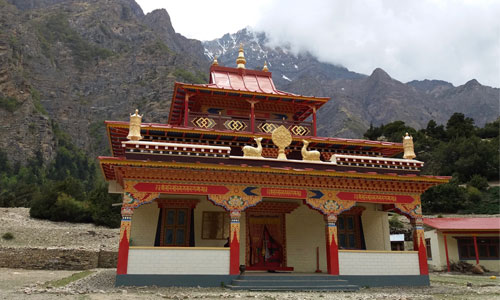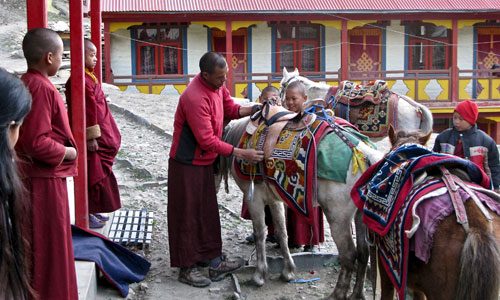WHY THIS MATTERS
Life is challenging in the high Himalayas.
Nepal’s per capita annual income is 728 USD, placing it 166th among 193 nations. At least 381,000 school-age children and youth remain out school. A much larger number attending school leave before completing high school (UNESCO, 2017). Nonetheless this represents considerable progress made by the Governments of Nepal over the past 50 years. The Northern Himalayan Region is home to most of Nepal’s Buddhist monasteries and communities. This region is also home to Nepal’s most economically impoverished families at the “bottom” of Nepal’s economic and educational progress.


Buddhist gönpas are the cultural and ethical heart of Nepal’s high Himalayan communities.
There are roughly 4,000 rural community gönpas or monasteries supporting school-age novice monks and nuns in these communities. Today most novices are from profoundly economically-impoverished families and community gönpas provide basic Buddhist instruction and economic relief with food, shelter, and clothing for these children. Gönpas serve as the cultural and spiritual heart of these Buddhist communities.
Gönpas and their communities struggle to survive.
Rural gönpas and their Buddhist communities struggle to survive in the land of Shakyamuni Buddha’s birth. Most novice monks and nuns leave the gönpa and monastic life during adolescence only to return to poverty. Children must seek scholastic education in the urban areas if their families can afford it, spending many years away from family, the village, and often the dharma. The large-scale social causes of decreasing novice retention in the gönpas, the increasingly impoverished origins of gönpa novices, and the educational separation of children from their families, communities, and often the dharma are not directly reversible. Nepal and the world will lose the communities and cultural heritage that has fed Vajrayana Buddhism for centuries if this continues.


Strengthening Buddhist gönpa communities through education.
Large-scale social change is not reversible. However, rural gönpas and their communities can take advantage of change in new ways in order to thrive. This is the approach taken by CGEIN. The scale of the challenge for high Himalayan Buddhist communities in Nepal has moved us to approach this through building partnerships with many of Nepal’s central monasteries and education-related NGOs and INGOs. CGEIN’s focus is on researching, developing, and sustaining a class 1-8 government-certified education program based in rural Buddhist communities that integrates academic subjects with basic dharma instruction for monastic and lay youth.

Life is challenging in the high Himalayas.
Nepal’s per capita annual income is 728 USD, placing it 166th among 193 nations. At least 381,000 school-age children and youth remain out school. A much larger number attending school leave before completing high school (UNESCO, 2017). Nonetheless this represents considerable progress made by the Governments of Nepal over the past 50 years. The Northern Himalayan Region is home to most of Nepal’s Buddhist monasteries and communities. This region is also home to Nepal’s most economically impoverished families at the “bottom” of Nepal’s economic and educational progress.

Buddhist gönpas are the cultural and ethical heart of Nepal’s high Himalayan communities.
There are roughly 4,000 rural community gönpas or monasteries supporting school-age novice monks and nuns in these communities. Today most novices are from profoundly economically-impoverished families and community gönpas provide basic Buddhist instruction and economic relief with food, shelter, and clothing for these children. Gönpas serve as the cultural and spiritual heart of these Buddhist communities.

Gönpas and their communities struggle to survive.
Rural gönpas and their Buddhist communities struggle to survive in the land of Shakyamuni Buddha’s birth. Most novice monks and nuns leave the gönpa and monastic life during adolescence only to return to poverty. Children must seek scholastic education in the urban areas if their families can afford it, spending many years away from family, the village, and often the dharma. The large-scale social causes of decreasing novice retention in the gönpas, the increasingly impoverished origins of gönpa novices, and the educational separation of children from their families, communities, and often the dharma are not directly reversible. Nepal and the world will lose the communities and cultural heritage that has fed Vajrayana Buddhism for centuries if this continues.

Strengthening Buddhist gönpa communities through education.
Large-scale social change is not reversible. However, rural gönpas and their communities can take advantage of change in new ways in order to thrive. This is the approach taken by CGEIN. The scale of the challenge for high Himalayan Buddhist communities in Nepal has moved us to approach this through building partnerships with many of Nepal’s central monasteries and education-related NGOs and INGOs. CGEIN’s focus is on researching, developing, and sustaining a class 1-8 government-certified education program based in rural Buddhist communities that integrates academic subjects with basic dharma instruction for monastic and lay youth.


